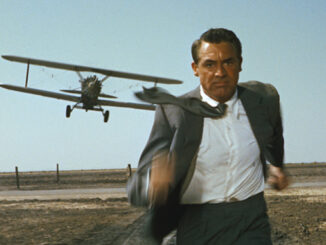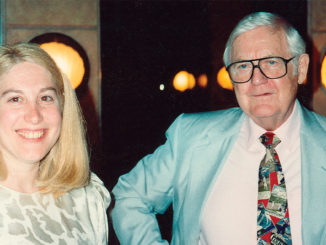
by Kevin Lewis
When A Chorus Line was conceived in the early 1970s from oral histories with dancers compiled by choreographer Michael Bennett, the Michael Powell film The Red Shoes (1948) was repeatedly mentioned as the inspiration for them to become dancers. Like Victoria Page, the tragic ballerina portrayed by ballerina Moira Shearer in The Red Shoes, they sacrificed their personal lives and happiness for their art. Marvin Hamlisch, the composer of A Chorus Line, paid homage to the film in “At the Ballet” and “What I Did for Love.”
However, The Red Shoes never needed A Chorus Line for its own immortality. Since its premiere 60 years ago in September 1948, the film has been a part of our lives and is the Gone with the Wind of dance films. It played for years in American art houses and created an audience for ballet, especially the New York City Ballet and Sadler’s Wells, in both Great Britain and America.
Co-directors, -producers and -screenwriters Michael Powell and Emeric Pressburger created a timeless movie because they avoided compromises. The fantasy and Gothic elements of the Oscar-winning set decoration and art direction by Hein Heckroth and Arthur Lawson lent credibility to the melodramatic and tragic story. By casting legendary and popular ballet figures as the ballet world characters, instead of stars with “dance-ins,” Powell achieved a roman á clef ambience. Though The Red Shoeslost the Academy Award for Best Picture (to Hamlet), it created an increased acceptance for British films in mainstream America.
The Red Shoes ballet, with its pulsating color and special effects, was the inspiration for Gene Kelly’s ballet in An American in Paris (1951).
Filmmaker Martin Scorsese was profoundly affected by the film and championed the other films of Powell, with and without Pressburger. He also thought that the color cinematography by Jack Cardiff in The Red Shoes was some of the most beautiful he had ever seen. Through the Film Foundation, which Scorsese founded in 1990, he is spearheading the restoration of the original three-strip nitrate Technicolor negatives of The Red Shoes. Robert Gitt, chief preservation officer at the UCLA Film and Television Archives, is overseeing the restoration in close collaboration with Scorsese and Thelma Schoonmaker, A.C.E., Scorsese’s principal editor (and three-time Oscar winner) and Powell’s widow. The restored version will be released next year.
Powell, who died in 1990 at the age of 85, was the sparkle in British cinema with not only The Red Shoes but also such color masterworks as The Thief of Baghdad (1940) (one of three credited directors), The Life and Death of Colonel Blimp (1943), A Matter of Life and Death (1946), Black Narcissus (1947) and The Tales of Hoffman (1951). He was unique in British cinema, and even world cinema, because of his early belief in what Technicolor could do for dramatic subject matter.
Color was vital to Powell because he was a painter at heart, an artist who boldly explored the exotic, magical, epic nature––literally the moving canvas––of his material. As Schoonmaker states, “Michael Powell was very lucky that his first job in film was under the direction of Rex Ingram, whose career in Hollywood was ruined because of his artistic battles with Louis B. Mayer. Ingram’s influence on The Red Shoes is evident in the exotic nature of the film and in its lush stylistic flourishes.”
In editing The Red Shoes, Reginald Mills useda series of fades and dissolves, which impart a musical editing structure,replete with leitmotifs.
Ingram himself most likely would have used color in his classic epic romances The Four Horseman of the Apocalypse (1921), Scaramouche (1923) and certainly The Garden of Allah (1927), if the color process had been available to him. Powell happily left a bank clerk job in England to join Ingram’s production unit in Nice, France, where Ingram escaped Mayer but still produced for MGM.
Powell returned to his native England and eventually was hired to direct “Quota Quickie” B movies, some for Warner Bros. and Gaumont-British, throughout the 1930s. Alexander Korda paired him with Pressburger and together they co-produced and co-wrote the series of now-classic movies for their production company, The Archers.
Powell was respected for his overall knowledge of all aspects of filmmaking, having been trained at Ingram’s studio as an editor and cameraman. His deep understanding of how films were made meant that he had tremendous control over how his films were visualized and edited. He and Pressburger disdained expository story construction, conceiving scenes as much as possible in purely visual terms rather than merely verbal ones.
Noreen Ackland, the assistant editor to Reginald Mills, The Archers’ primary film editor, recalls that Mills “didn’t like using dissolves and fades and preferred direct cuts.” However, in The Red Shoes, for which he received an Oscar nomination for editing, Mills used a series of fades and dissolves, which impart a musical editing structure, replete with leitmotifs.
Writer Nancy Dennis, who regards The Red Shoes as one of the few profound films about creativity, interviewed 73 actors, technicians, editors and writers––including Powell himself in 1979––for an unpublished book called The Red Shoes: Fairy Tale Film. She thinks it is fitting that the film, The Archers’ most brilliant and self-revealing work, was set in the Monte Carlo Opera House, just a few miles from Powell’s artistic beginnings 20 years earlier.
Since its premiere 60 years ago in September 1948, the film has been a part of our lives and is the Gone with the Wind of dance films.
“I mentioned one dissolve that I particularly liked, from the Les Sylphides excerpt with Moira Shearer in Arabesque penchée, where the line of her raised leg matches the curve of the winged figure outside Boris Lermontov’s office,” she recalls. “Powell opined that it was probably both conscious and accidental: ‘I would say it’s a bit of both because the idea of tracking back from the figure and the actual continuity would be ours on the floor and then the actual moment of blending the two images would be the editor’s… I didn’t want to just come back into an office, so we came to the figure and pulled back. And then when Reggie matched the two together, he probably saw the relationship and he would obviously take the happiest moment of the two––and probably we wouldn’t even know how well it would work until he showed us the experimental results.’”
Dennis adds that Mills was the perfect editor for this film because “he was an ardent ballet and music fan.” She adds, “Powell brought a penchant for the mystical and fantasy,” which sustains the fairy tale nature of this contemporary updating of the Hans Christian Andersen story.
The Red Shoes ballet, with its pulsating color and special effects, was the inspiration for Gene Kelly’s ballet in An American in Paris (1951). The Red Shoes ballet is completely cinematic and original, including the Brian Easdale score, for which he received an Academy Award. Mills, working with cinematographer Cardiff, created such editing tricks as a swirling newspaper evolving into a dancer.
Schoonmaker is impressed that Powell and Pressburger’s films are still so powerful and may be even more appreciated today than when they were produced. Powell never shied away from unconventional themes, and imbued his films with an almost pagan love of landscape. He relished the poetic and mysterious images he packed into his films. As he proved in The Red Shoes and his other films, Powell (for whom Pinewood Studios recently named its sound mixing theatre) was an audacious visual and editing magician who prided himself, as Schoonmaker says, “in staying one step ahead of the audience.”





